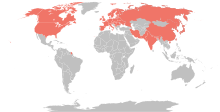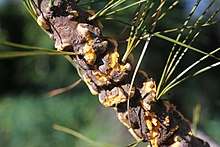Cronartium ribicola
Cronartium ribicola is a species of rust fungus in the family Cronartiaceae that causes the disease white pine blister rust. Other names include: Rouille vesiculeus a cinq feuilles pin (French), white pine Blasenroste (German), moho ampolla del pino blanco (Spanish).[2]
| Cronartium ribicola | |
|---|---|
 | |
| Cronartium ribicola on western white pine | |
| Scientific classification | |
| Kingdom: | Fungi |
| Division: | Basidiomycota |
| Class: | Pucciniomycetes |
| Order: | Pucciniales |
| Family: | Cronartiaceae |
| Genus: | Cronartium |
| Species: | C. ribicola |
| Binomial name | |
| Cronartium ribicola J.C.Fisch. | |
 | |
| Distribution of Cronartium ribicola[1] | |
| Synonyms | |
|
White pine blister rust | |
Cronartium ribicola is native to China, and was subsequently introduced to North America. Some European and Asian white pines (e.g. Macedonian pine, Swiss pine and blue pine) are mostly resistant to the disease, having co-evolved with the pathogen.


It was accidentally introduced into North America in approximately 1900, where it is an invasive species causing serious damage to the American white pines, which have little genetic resistance. Mortality is particularly heavy in western white pine, sugar pine, limber pine and whitebark pine. Efforts are under way to select and breed the rare resistant individuals of these species; resistance breeding is concentrated at the United States Forest Service Dorena Genetic Resource Center in Oregon and the Moscow Forestry Services Laboratory in Idaho.
Some limited silvicultural control of the disease is possible. If bark blisters are found on branches over 10–15 cm from the trunk, those branches may be pruned off, which will stop the spread of the disease to the rest of that tree. If the main trunk is affected then no control is possible, and the tree will die once the infection encircles the tree. Infected trees are often identified by "flagging", when all the needles on a branch turn brown and die. Infections often occur on low branches close to the ground on young trees, so pruning of white pine can also be effective in multiple ways, as it improves the quality of timber by creating more knot-free timber, and reduces the likelihood of infection from the blister rust to a small extent. Another form of control practiced in some areas is to diligently remove Ribes plants from any area near white pines, including the blackcurrant. Because the infection moves from currant plants, to pines, and back again, it cannot continue to exist without its secondary (telial) host. Although effective in theory, removal of currants is rarely successful in practice, as they readily re-grow from small pieces of root left in the soil, and the seeds are very widely spread in birds' droppings. According to the Southwest Oregon Forest Insect and Disease Service Center, white pine blister rust attacks all five-needle pines. "Damage [to plants] includes mortality, top kill, branch dieback, and predisposition to attack by other agents, including bark beetles."[3]
Hosts and symptoms
As is common among rusts, the life cycle of Cronartium ribicola includes two host species and goes through five spore stages, this is termed heteroecious. In the specific case of Cronartium ribicola, the aecial host of this pathogen is the white pine (Pinus subgenus Strobus, family Pinaceae) and the telial hosts are those of the genus Ribes, specifically currants and gooseberries. Species of both telial and aecial hosts have varying levels of resistance or immunity to infection.
On the aecial host, the first signs of C. ribicola are yellow or red spots on the Pinus needles, but these are small and can be difficult to see; more visible symptoms on the aecial host includes perennial cankers which appear on the branches within two years of infection. Looking at the infected plant as a whole, the Pinus will appear chlorotic, and stunted with dead branches or tops that turn a bright red color.[4]
On the other hand, the telial host, Ribes, can contract yellowish chlorotic leaf spots, but is otherwise not significantly impacted. The signs of C. ribicola on Ribes, come in the form of the pathogen itself as orange pustules on the underside of the leaf.[2]
Environment
Environmentally, Cronartium ribicola prefers cooler temperatures coupled with moist conditions in low-lying areas, especially during the late summer and early fall. The low temperatures and humidity are an essential part of the pathogen's spore germination and dispersal requirements. The combination of cooler temperatures and a high humidity create an environment at which dew can easily form. The free water helps loosen spores adhered to a leaf’s surface and promotes spore germination.[5]
At a microclimate scale, lower trees hidden below the canopy exist in a lower temperature and moister environment, and as a result, these young trees are more susceptible to C. ribicola than the older, taller trees that create the canopy, which consequently have more access to the warm, dry sun. This collection of environmental characteristics are common in the Northern Hemisphere, causing many areas in the United States to be labeled at hazard zones for the genus Pinus.[6]
Disease management
Historically, tactics such as alternate host removal and planting restrictions in hazard zones, as well as quarantines made legal by the 1912 Plant Quarantine Act. Removal of Ribes used to be practiced in full force, which heavily affected blackcurrant production in the United States, however through a combination of the pathogen’s hardiness and ability to travel airborne for nine hundred feet, as well as the Ribes ability to regrow from an extremely small root portion, researchers have focused their efforts on creating new cultural practices to lower the abundance of C. ribicola. Since then researchers have come up with multiple new methods to curb the spread of the infection.
For example, careful topological selection of plot sites for the white pine would greatly reduce the germination of spores. These plots would include land with characteristics such as well-drained soil such as that on a high-sloped area, spots that are well aerated, and face the south for dryness and warmth. This would remove the wet, damp environment that is crucial for the germination of the spores on the Pinus.[7]
Once plantation spots have been chosen, pruning and inspection practices have been adapted as a monitored cultural practice. Inspections for blister rusts begin in May about six years after the trees are planted. This time period is when obvious symptoms of C. ribicola begin to appear, such as red needles. Infected branches will be pruned to a certain height that is dependent on a rate of infection determined by researchers; generally pruning is required for Pinus trees up to anywhere between nine and eighteen feet.[8] Pathological pruning, in which all lower branches are pruned regardless of signs or symptoms of infection, may reduce disease instance in white pine tree stands.[9]
Furthermore, genetic hybridization testing has been conducted for more than half a century in order to find resistance among strains of the species, and have since successfully introduced resistance into the eastern white pine[7]
References
- "Cronartium ribicola (white pine blister rust)". CABI.org. 2019-11-19. Retrieved 2020-06-16.
- "White pine blister rust". www.apsnet.org. Archived from the original on 2016-11-22. Retrieved 2016-12-07.
- "White pine blister rust". Department of Agriculture Forest Service. Archived from the original on 27 May 2009.
- "Forest Pathology - White Pine Blister Rust". www.forestpathology.org. Archived from the original on 2008-05-02. Retrieved 2016-12-06.
- Simren, Brar (2012-08-31). Landscape genetics of Cronartium ribicola (Thesis). University of British Columbia. doi:10.14288/1.0073107.
- Van Arsdel, Eugene (2006). "Epidemiology for Hazard Rating of White Pine Blister Rust" (PDF). US Forest Services.
- Laflamme, Gaston (2012). "White Pine Blister Rust: Knowledge, Control, and Innovation" (PDF). cfs.nrcan.gc.ca/. Canadian forest Service-Laurentian Forestry Centre. Retrieved December 6, 2016.
- "HOW to Manage Eastern White Pine to Minimize Damage from White Pine Blister Rust and White Pine Weevil". www.na.fs.fed.us. Retrieved 2016-12-06.
- Lehrer, G.F. (1982). "Pathological pruning: a useful tool in white pine blister rust control". Plant Disease. 66: 1138–1139.
External links
- Don't Move Firewood - Gallery of Pests: White Pine Blister Rust
- forestpathology.org
- Dorena Genetic Resource Center, United States Forest Service
- The Sugar Pine Foundation
- The Whitebark Pine Ecosystem Foundation
- Species Profile - White Pine Blister Rust (Cronartium ribicola), National Invasive Species Information Center, United States National Agricultural Library. Lists general information and resources for White Pine Blister Rust.